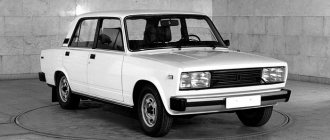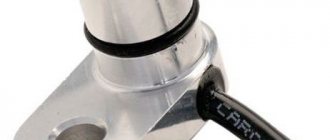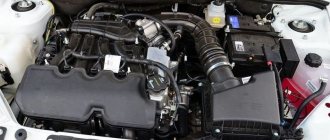The official website of the Lada company indicates that Granta production in 2011 has already produced 2 generations and 35 modifications of cars, with engine packages that support the EURO IV environmental standard with volume: 1596, 1597 cm3 and power: 82, 87, 98, 106, 114, 118 l ./s., using as fuel: gasoline, grade AI-95, with gearbox: automatic, manual, robot. And the fuel consumption of the Lada Granta in the mixed, urban (in the city) and suburban (on the highway) cycle ranges from 5.2 to 10.1 liters per 100 km, which, with a tank volume of 50 liters, allows you to travel a distance of 500 km. up to 960 km..
Fuel consumption per 100 km for Lada Granta (2011 - 2015), Sedan, Liftback, 1st generation
| Modification | Fuel consumption, l/100 km | Power reserve (km.) | ||
| highway | city | MIX | ||
| 1596 cm³, 118 hp, tank (50 l.) - AI-95, manual transmission, front-wheel drive | — | — | 7.8 | up to 641 |
| 1596 cm³, 98 hp, tank (50 l.) - AI-95, automatic transmission, front-wheel drive | 6.1 | 9.9 | 7.2 | 510 — 820 |
| 1596 cm³, 106 hp, tank (50 l.) - AI-95, manual transmission, front-wheel drive | 5.6 | 8.6 | 6.5 | 580 — 890 |
| 1596 cm³, 87 hp, tank (50 l.) - AI-95, manual transmission, front-wheel drive | 5.8 | 9 | 6.6 | 560 — 860 |
| 1596 cm³, 82 hp, tank (50 l.) - AI-95, manual transmission, front-wheel drive | — | — | 7.4 | up to 676 |
| 1597 cm³, 98 hp, tank (50 l.) - AI-95, manual transmission, front-wheel drive | 5.8 | 8.7 | 7.3 | 570 — 860 |
| 1596 cm³, 87 hp, tank (50 l.) - AI-95, automatic transmission, front-wheel drive | — | — | 7.7 | up to 649 |
| 1596 cm³, 106 hp, tank (50 l.) - AI-95, manual transmission, front-wheel drive | 5.6 | 8.6 | 6.7 | 580 — 890 |
| 1596 cm³, 114 hp, tank (50 l.) - AI-95, manual transmission, front-wheel drive | 6.8 | 10.1 | 8.6 | 500 — 740 |
| 1597 cm³, 87 hp, tank (50 l.) - AI-95, manual transmission, front-wheel drive | 5.8 | 9 | 7 | 560 — 860 |
| 1596 cm³, 98 hp, tank (50 l.) - AI-95, manual transmission, front-wheel drive | 5.6 | 8.8 | 6.8 | 570 — 890 |
| 1596 cm³, 106 hp, tank (50 l.) - AI-95, manual transmission, front-wheel drive | 5.2 | 9 | 6.5 | 560 — 960 |
| 1596 cm³, 87 hp, tank (50 l.) - AI-95, manual transmission, front-wheel drive | 5.8 | 9 | 6.6 | 560 — 860 |
| 1596 cm³, 106 hp, tank (50 l.) - AI-95, manual transmission, front-wheel drive | 5.6 | 8.6 | 6.5 | 580 — 890 |
| 1596 cm³, 98 hp, tank (50 l.) - AI-95, automatic transmission, front-wheel drive | 6.1 | 9.9 | 7.2 | 510 — 820 |
| 1596 cm³, 106 hp, tank (50 l.) - AI-95, manual transmission, front-wheel drive | 5.2 | 9 | 6.5 | 560 — 960 |
Grants Features with automatic transmission
When designing a car with AvtoVAZ, the automatic transmission did not reinvent the wheel, but purchased a ready-made transmission from JATCO. This gearbox is widely installed on Japanese cars and is very reliable. without The manufacturer of false modesty claims a resource that exceeds the service life of the car. Time However. will show and it is now clear that it is unlikely that an imported component will be able to ruin a domestic car.
on the contrary, it will most likely benefit Lada. To adapt it, it was necessary to reduce the ground clearance by 2 cm. Moreover, due to the fact that such a car turned out to be heavier than usual, the rigidity of the body had to be increased and the suspension strengthened. In total, AvtoVAZ designers needed to install 30 new Whats.
The units are especially nice; they used a massive gear shift knob, thereby pleasing some car enthusiasts. But the indication that the mode is on is visible only on the instrument panel; additional lighting on the handle would lead to a slight increase in the transmission. prices are four-tiered. In addition, it has an off-road position for “1” and “2” for use in urban areas.
conditions there is also a button to disable overdrive. Indispensable It is on long climbs, however, fuel consumption is significantly affected. This parameter is a sore subject for all owners of Lada automatic transmission with Grant. It is also relevant for cars with classic Very. The transmission is often a subjective criterion, as it depends on many reasons.
Lada Granta fuel consumption calculator: calculate mileage consumption
Using the calculator, you can calculate the fuel consumption for your trip.
The calculator accepts data from the form for the distance of the expected trip in kilometers and helps to calculate the possible fuel consumption in liters. Please note that the data for calculation are taken as averaged for the model; only the maximum and minimum consumption values are taken into account, which may differ depending on the modification of the car. Therefore, the calculation is averaged. liters
km
Calculate
With real fuel consumption in liters, the travel range (depending on the configuration and modification of the car) will be:
- with a consumption of 5.2 liters per 100 km, you can travel a distance of kilometers
- with a consumption of 10.1 liters per 100 km, you can travel a distance of kilometers
To travel a distance of kilometers, you will need (depending on the configuration and modification of the car):
- with a consumption of 5.2 liters per 100 km, liters of fuel are required
- with a consumption of 10.1 liters per 100 km, liters of fuel are required
How to determine the consumption of FL Grants yourself in order to verify consumption on a computer?
One of the ways to check this is using the control alarm method or taking into account the fact that the fuel minimum warning light comes on when there is approximately 6-7 liters of gasoline remaining. When this signal appears, the Grant FL must be refueled, as they say, to capacity (until the refueling nozzle is triggered).
After the car is refueled, the odometer must be reset to zero before driving. The equipment must be used in the mode familiar to the owner until the next time the low fuel warning light comes on.
Again, they refuel the car until the tank is full and the actual fuel consumption of the Lada Granta can be easily determined from the refueling receipt and the odometer reading. And then you need to compare the calculated consumption with the specific fuel consumption reading on the computer.
Important! The final measurement results may vary greatly due to the quality of the fuel, so you should refuel at the same gas station. By the way, this method is applicable to choosing a gas station with the highest quality fuel. Here the relationship is inversely proportional - the lower the specific consumption, the better the gasoline.
Lada Granta fuel consumption table by kilometer
The table contains the distances most often of interest and the corresponding fuel consumption indicators by kilometer for the Lada Granta. The data in the table is averaged and does not take into account the modification and equipment of a particular car, but uses the average data for the model.
| Distance (km.) | Fuel consumption, l | ||
| MIN (track) | MAX (city) | ||
| 200 (two hundred) | 10,40 | 20,20 | |
| 300 (three hundred) | 15,60 | 30,30 | |
| 400 (four hundred) | 20,80 | 40,40 | |
| 500 (five hundred) | 26,00 | 50,50 | |
| 600 (six hundred) | 31,20 | 60,60 | |
| 700 (seven hundred) | 36,40 | 70,70 | |
| 800 (eight hundred) | 41,60 | 80,80 | |
| 900 (nine hundred) | 46,80 | 90,90 | |
The world's main methods for measuring the consumption of new cars
As we wrote above, there are several methods for measuring the average fuel consumption of cars. Let's tell you more about them.
NEDC
In Europe, the most commonly used cycle is the NEDC type, which was developed about forty years ago. This causes reproaches from experts who talk about the outdatedness of the method.
NEDC Algorithm Structure
The main features can be considered that manufacturers are allowed to use a selective method for selecting a machine. We are talking about the fact that for testing we provide cars with already run-in components, special lubricants of low viscosity, as well as with the most compact tires that can be installed on a car.
In addition, if desired, testing can be carried out with the radio, heating, and so on turned off. This allows you to “select” those results that would best suit the manufacturer.
Measurements are carried out in the urban (NEDC UDC) and suburban (NEDC EUDC) cycles. The length of the "urban test" is 780 seconds, while the suburban test involves a period of time equal to 400 seconds. In the first case, the average speed will be a little over 18 kilometers, and in the second - about 62.6 kilometers per hour.
This technique is criticized for the reason that many models with an additional electric motor can travel most of this short distance without using the internal combustion engine. This becomes the source of amazing results with extremely low fuel consumption, even in sports cars.
FTP-75
But these standards no longer meet market requirements, so manufacturers are increasingly turning to the American standard FTP-75. It is considered the closest to reality, although experts talk about problems with the lack of areas where movement occurs evenly.
FTP-75 algorithm speed dependence
It is similar to the European NEDC, including an average speed of 34.1 kilometers per hour. Another advantage is that the test duration is 1874 seconds, so it is more difficult for hybrid car models to show “unrealistically low” fuel consumption figures. But what is most important is that the American version of the test obliges manufacturers to include air conditioning if it is included in the package.
As a result, fuel consumption in this test is higher than in NEDC by 10 or even 20 percent.
Japanese cycle JC08
In the case of JC08 the difference will be even greater. The fact is that in it the number of accelerations and decelerations is maximum, and there are no long sections with even speed parameters at all.
In addition, the maximum speed does not exceed 80 kilometers per hour. On one of the sections, the length of which is 8.2 kilometers, the average speed does not even reach 25 kilometers per hour.
The slowest known method for calculating average flow
Of course, we can talk about the severity of the test, but it takes into account the increased load on the streets, which is typical for the island country of Japan. In addition, drivers in most large cities around the world find themselves in such conditions. So, it is worth considering this technique as the closest to reality.
In general, there is no optimal testing method yet. The current options represent a compromise that automakers are trying to use to their advantage. Therefore, you should always try to take into account the specific technique that gave the results specified in the vehicle specifications.
Factors affecting consumption
Not a single car enthusiast can say exactly what fuel consumption his car has. Before the number, he will definitely use the adverb “somewhere” and indicate under what conditions. Of course, he is absolutely right. Fuel consumption by a car is not constant and depends on many conditions.
- Technical condition of the engine. It would seem that this is irrelevant for a new car. It has to be perfect, and 99 times out of 100 it is. However, there is such a thing as ECU firmware. Experts assure that if it is factory, the consumption will be increased. This does not mean at all that you need to drop everything and run to change the fill. This should be done only after carefully weighing everything, and only with an experienced specialist.
- Car load. Doesn't need much explanation. The more things you fit into your trunk, the more energy required by the laws of physics to deliver them to their destination. Where do you get it from if not from the fuel tank?
- A large number of switched on consumer devices makes it more difficult for the engine to turn a loaded generator. The result is excessive consumption of gasoline.
- Using an air conditioner leads to excessive consumption for the same reason.
- Movement speed. 90-120 km/h is considered optimal. It is with these figures that the suburban cycle is calculated.
- The quality of gasoline and its underfilling. They are not the last factor influencing the frequency of visits to gas stations. In addition, the use of low quality fuel significantly affects the engine life. Refuel only at trusted stations.
- Driving style. It's no secret that driving skills have a significant impact on fuel consumption. If you drive in second gear where you can use fourth, the readings from the on-board computer will greatly surprise you. The same will happen to drivers who consider themselves experienced and use an aggressive driving style.
- Transmission. Not only the condition, but also its type. In the case of a mechanical one, it is possible to influence fuel consumption. True, not always to a lesser extent. Owners of cars with automatic transmission are practically deprived of this. Maybe that’s why you can so often hear statements about the gluttony of the Lada Granta automatic car.
Fuel quality
Not only the level of fuel consumption, but also the reliability of the corresponding components may depend on this aspect. Here, the manufacturer strongly recommends using only 95 gasoline. It is this brand, according to numerous observations of owners and experts, as evidenced by many reviews from owners, that can extend the time until the next required refueling. We should not forget the fact that the primary and important indicator for fuel is its quality, and not the octane number. Similar to the proverb: “Check seven times, and fill once”!
Owner reviews
“I initially didn’t really like the appearance of the new VAZ model, but when the liftback version appeared, I seriously thought about buying it. After saving a little, I bought it. I can say that for a Russian car, everything here is not even bad. The interior is rather rustic, but there is a lot of stuff even in the basic version. Over several years of use there was not even a hint of anything breaking. Due to its small size, the car is well suited for city use. But I also enjoy driving on the highway. Here the VAZ engine performs well, allowing you to quickly gain the speed necessary for a comfortable ride. It's a pity that the car has high consumption. The version with automatic transmission consumes up to 12 liters in the city, and on the highway it reaches 8,” writes Grigory from Podolsk.
“When I was choosing a car, I paid attention to many parameters. The main one was fuel consumption. According to the reviews that I read a bunch, Granta’s was not great. And so, in 2014, I bought it. What’s attractive is that it was made with our roads in mind. Although the suspension is stiff, you don’t feel any bumps or potholes. But in the cabin everything is not so rosy. It itself is made so-so, it constantly sticks together and rattles, and the sound insulation suffers, which is why many sounds from the street can be heard. But the cost of gasoline really turned out to be minimal. My consumption rate is 8 liters, and in winter the consumption does not exceed 10 liters,” says Victor from Lipetsk.
And this is Ilya’s review from Tolyatti:
“I’ve always driven foreign cars, but after mine began to break down often, I started thinking about buying a new car. I noticed a new product from the domestic automobile industry - the Grant liftback. During the first year of driving I did not experience any problems at all. Everything was perfect both technically and comfort-wise. But recently the dashboard began to creak, and the sound insulation also became unusable. This is very annoying and does not allow you to relax on long trips. The solution to the problem is listening to music at medium volume. Otherwise, everything is good so far. I like the dynamic performance, and my wife is happy with the trunk, which can accommodate all her many purchases. In terms of consumption, I will say that it is acceptable and does not exceed 10 liters in the city.”
“The first thing I want to say after using the car for a year is that the car is ideal for our roads. It's set high, the suspension is stiff with decent travel, so you don't feel any potholes, of which we have a lot. Nothing has broken yet, the service was only to replace consumables. He looks great, always loved compact cars. The feel of the interior is a little worse; they clearly saved on the quality of the assembly and materials. But there is a lot of free space, which is good news. I drive mostly around the city and rarely go outside, so it takes a lot of fuel. The norm for me is 10 liters,” notes Vitaly from Omsk.
And this is how Philip from Rostov speaks about his choice:
“I don’t regret that I bought this particular car at the time, although there were many options. He has never let me down yet. Perfect for use both for city needs and for long trips. Good cross-country ability and unpretentiousness allow you to drive even where there are no roads at all. The engine pulls vigorously, speed and acceleration are quite enough. It consumes 1 liter of fuel in the city and 8 on the highway.”
“During the time that I have been using the car, I have realized that if you look after it and care for it properly, it will last for many years. So, in 3 years of driving, I have never visited a repair shop for serious reasons. I made all replacements of consumables in a timely manner. The only thing I don't like about it is the interior quality. At high speed it will rattle and rattle a lot. Otherwise, everything is fine and I’m definitely not going to change the car,” writes Stanislav from St. Petersburg.
The Lada Granta was released by AvtoVAZ in 2011. It replaced the Kalina model and the fuel consumption of the Lada Granta per 100 km is significantly different from its predecessor.
Driving style
Fuel consumption also largely depends on it. Fans of speed and spectacular starts with sudden stops spend more fuel than calm car owners.
Moreover, when the driver constantly starts with a cold engine, the amount of gasoline burned usually increases by approximately 12 percent.
As previously noted, the operation of various electronic systems, including air conditioning, also requires fuel. The more gadgets and gadgets installed on a car, the more difficult it is to save gas.
Only one air conditioner can “eat” an additional 15 percent of the total volume.
LadaGranta 1.6 (87 hp)
Due to the high cost and high fuel costs, cars with a robotic gearbox are in less demand among potential Lada Granta owners. A very significant factor when taking into account the consumption of a Lada Grant is the vehicle’s equipment; here it is important to understand that by vehicle equipment we mean all sorts of variations in the assembly of the model, such as different bodies, engines, mechanical parts and electronic equipment, officially presented by the manufacturing company.
Fuel quality
Reviews from owners of Grants indicate that the amount of consumption varies significantly depending on what kind of fuel is used to refuel it.
The manufacturer, for its part, recommends giving preference to a better brand, that is, AI-95. Moreover, practice confirms that the above-mentioned grade of gasoline is burned more economically than the cheap 92nd grade. At the same time, the difference is so significant that it is more profitable to use expensive fuel.
This circumstance should also be taken into account in order to optimize the operating costs of the vehicle in question.
Sedan and liftback body
First of all, the (standard equipment) is simple and has only the most necessary options. That is, there is only one airbag installed in the car, which is intended for the driver. Further, the Lada Granta Standard is equipped with a 1.6-liter eight-valve engine with a power of 80 horsepower. The appearance of this “Grant” is also simple: the bumpers are not painted, there are no caps or grilles. But there are stamped 13-inch wheels and daytime running lights, which still give it some kind of solidity.










